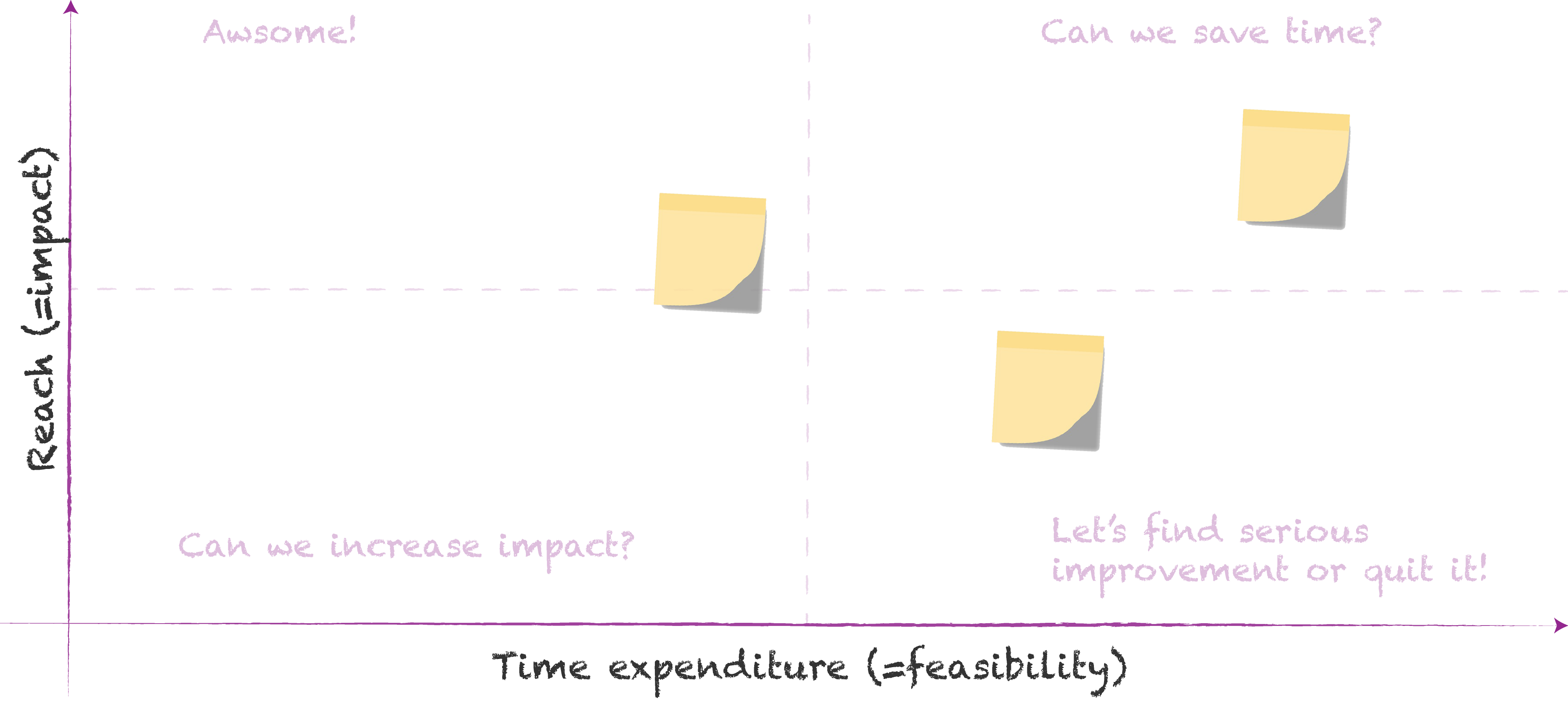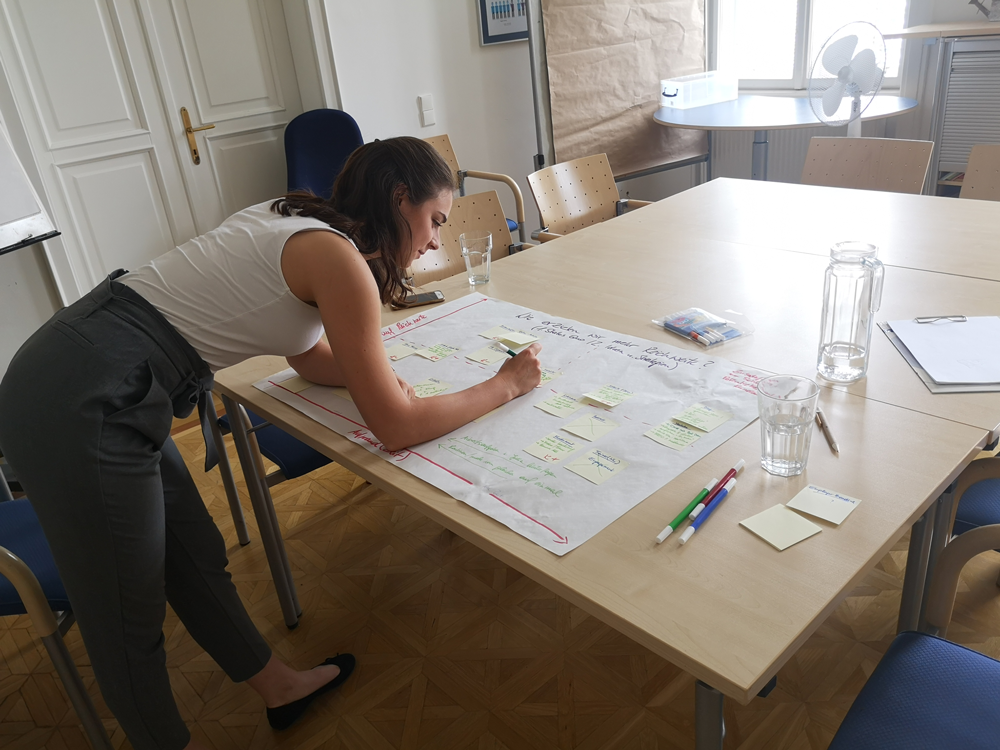We’re two people, we’re responsible for marketing and have 13 channels to feed and administrate on a regular basis. Not to talk about the many other tasks cumulating in the vast field called “marketing”. Oh, and we have only 49 working hours – together! So no wonder we’re constantly trying to find ways to save time, have more outcome and – when pressure is high – show what we’re doing to have expectations of possible extra challenges straight. The tiny little and super effective tool we tried lately is called “Impact & Feasibility Matrix”.
The matrix
Brought to our attention by MDI trainer and facilitation expert Toni Chung during a Design Thinking webinar, the outlook of better resource allocation immediately spotted our attention. A quick Google research showed: The matrix comes in many different shapes – and it’s not rocket science! If you know the Boston Consulting matrix you already know how it’s done. And if you know the concept of importance & urgency matrix – you also have everything on hand to get started. And even if not: It will take you only a few minutes to understand the principle and be ready to go.
When choosing the method, our expectation was high:
- Gain clarity about what we do so that we are able to show it to others as well.
- Know where and how we can save time.
- Know where and how we can increase the impact of our tasks.
- Walk the talk by trying different tools ourselves, this time from the big field of Design Thinking.
How it’s done
We decided to approach the whole thing on the basis of the channels we have to take care of. And in the short amount of 1 hour we wanted to get the maximum out of the tool so we prepared a simple flipchart with two axes: horizontal to map time effort for a specific channel, vertical to map the outcome measured by the number of people we reach with a the channel. You can even use a third dimension, visualized for example by the size of a bubble in the matrix or other visual markers. We choose potential effect on the number of customer requests we receive out of a channel.
To anticipate the key message of this article right now: it worked so well! Because the tool is as simple as effective. So if you want to try it for your team or your individual work as well, this is what you can do.

That’s how an Impact & Feasibility Matrix can look like.
Step 1 – The mapping
Prepare the mentioned flipchart (or whiteboard, or excel file, or fancy digital tool) and write all your “things” on a post-it (or other format fitting to your tool). Then gather your team or a representative group of it, give everyone a little pile of the post-its and start sticking them in silence wherever you think they fit best. If you have detailed data on hand – for example for the number of reach, any results from time measuring tools like Kanban-Flow and so on – even better.
Step 2 – The discussion
After everything is distributed on the matrix, address it one by one with the whole group, discuss if everyone is okay with where it’s positioned and adjust accordingly, if not. Doing so, you’ll be immediately amazed by the insights you gain about how your employees and colleagues perceive the tasks they do, about what understanding they have of “much time needed” and “not much time needed” and many other interesting arguments, ideas and concerns about the specific things you’re looking at.
Step 3 – Outlook & improvement ideas
Now it’s time to address each post-it again and ask yourself specific question: How can we minimize the time needed? Or how can we reduce complexity? How can we increase the impact? Or how can we solve this in order to move it to a more favorable field on the matrix? In order to save time, you can also do this step together with the discussion mentioned before. And never forget to write things down!
Possible application fields and benefits
We experienced a perfect fit of the tool for the challenges we face in marketing in terms of “much to do – not much time”. Rumor has it that many people face this challenge so I’d anticipate a very good fit other teams within a company as well. 😉
Further fields of applications could be: Priorities in your teams measured by time needed and impact on company goals, for example when you work with OKR and try to evaluate which key results to go for.
Or you use it after a brainstorming/creation sessions to decide on what to work and what to postpone based on the axes potential positive outcome for your team and time needed to achieve it, for example. Here it could be an idea to add “costs” as a third factor as well.

Impact & Feasability Matrix Meeting.
And when it comes to summarize the benefits of this tool, it’s just the magic that happens when people talk with each other while having a clear goal, an open mind and a creative focus:
With the impact feasibility (or other) matrix:
- You gain valuable insights about the “things” you place on your matrix.
- You gain valuable insights about your colleagues/employees and their interests, concerns, ideas and way to work.
- You find creative solutions that you probably hadn’t seen in your daily work life.
- And by writing everything down you have a solid base for your next meeting or discussion. Or simply for the upcoming weeks and months of work and priorities in your team.
As already said, we only invested one hour meeting time and about half an hour of research and preparation time in advance and already have outcome we’re very happy with. If you can allocate the time, it would not hurt to invest two to three hours in the meeting and maybe even present it to your managers if you need to support a decision/request you have.
So what are you waiting for:
Don’t be shy, just apply! 🙂

